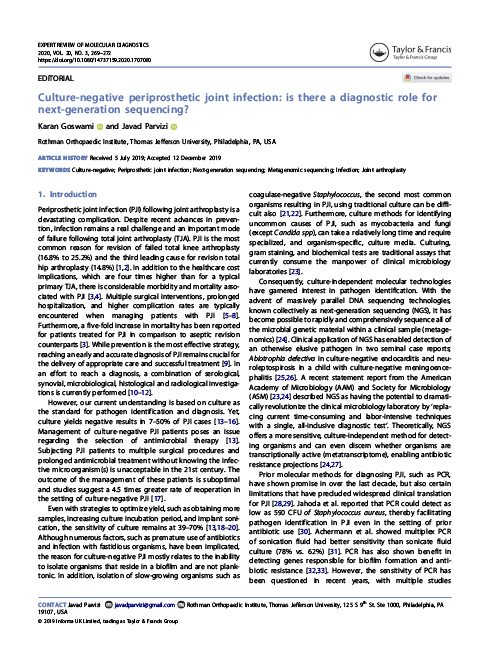51 results found for: Periprosthetic joint infection
MicroGenDX Laboratories equipped a multicenter study with its gold standard NGS test to investigate the persistence of Periprosthetic Joint Infection (PJI). Renowned orthopedic surgeon Javad Parvizi, MD will take the podium at American Association of Hip and Knee Surgeons (AAHKS) to discuss results of the study to show how NGS is revolutionizing the microbial diagnosis of chronic infections in orthopedics. Click Here to Read Full Article…
Expert Rev Mol Diagn. 2020;20(3):269-272. Editorial: This review explores the utility of next-generation sequencing (NGS) in diagnosing microbial pathogens in periprosthetic joint infections (PJI). Theoretically, NGS does not suffer from the limitations associated with PCR and culture methods. NGS offers advantages such as processing speed and accuracy, among others. Although several questions regarding the clinical application of NGS remain, review of the literature finds NGS recognizing a greater number of PJI-dwelling microbes and a broader base upon which to apply treatment options. Read Editorial…
J Arthroplasty. 2019;34(7):1333-1341. Study: A comparison was made between culture-based techniques and next-generation sequencing (NGS) relating to cost-effectiveness in diagnosing periprosthetic joint infection (PJI) after total knee arthroplasty. NGS is more sensitive than culture-based techniques for identifying microorganisms but is less specific and more expensive. A Markov, state-transition model projecting lifetime costs and quality-adjusted life years (QALYs) was constructed to determine the cost-effectiveness from a societal perspective. The primary outcome was incremental cost-effectiveness ratio, with a willingness-to-pay threshold of $100,000/QALY. Culture was not cost-effective compared to NGS, with an incremental cost-effectiveness ratio of $422,784 per QALY. One-way sensitivity analyses found […]


